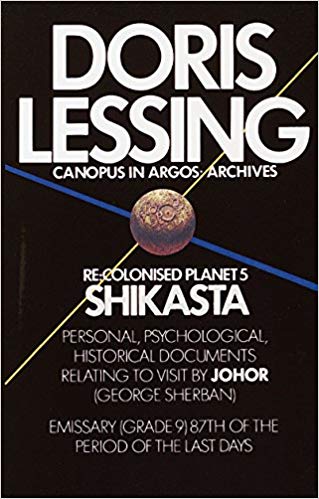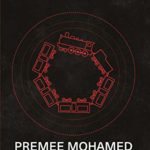In an era when science fiction insists on “showing” rather than “telling”, Doris Lessing’s Canopus in Argos: Archives series challenges readers to think differently. In five books, starting with Shikasta in 1979, she produced an epic scale work more in the vein of Olaf Stapledon’s universal histories than current best-sellers, and no less dazzling and thought-provoking.

Some early reviewers attacked Lessing for succumbing to the “razzmatazz” of science fiction. SFF critics didn’t take too kindly to this work either since it ignored many of the conventions of the genre. But Lessing, who had already produced challenging books exploring a near future apocalypse (The Memoirs of a Survivor and The Four Gated City) and the dream world of the psyche (Briefing for a Descent into Hell), found renewed inspiration in an imaginative arena that opened new worlds and ideas to explore. She re-envisioned nothing less than the entire span of earth and human history.
In the universe of these five books, cosmic forces enable life to thrive at certain times, fail at others. Galactic empires experiment to create societies on thousands of planets, sometimes to uplift them, sometimes only to dominate and oppress.
Galactic Empires of Human Nature
In a sense, the stories are fables, projecting earthly struggles against a background of empires that capture the best and worst of humanity in their competing efforts to shape its destiny.
Canopus, technologically the most advanced of the empires, tries to guide its thousands of colonized planets according to a higher ‘necessity’ perceived in the universal order. Its agents instruct subject peoples to a technical and cultural level where they can live in harmony with that order.
It establishes a cosmic lock on the planet to maintain this spirit, but, in the case of this alternate earth, that lock breaks through a shifting of planetary alignments. Rohanda (the fruitful) becomes Shikasta (the damaged) and a competition among rival empires intensifies for control over its destiny.
Shammat, the driving power of the Puttioran empire, cultivates the more destructive human drives toward power and dominance. It generates emanations of noxious influence across the globe to counter Canopean harmonies. Where Canopus fosters compassion, empathy and a sense of common purpose and merged consciousness, Shammat instills individualism, confusion and a drive for power.
To tell the story of a broken earth, Lessing shaped Shikasta as a complex archive, rather than a single narrative. She juxtaposes the “recreated” memories of the Canopean agent Johor with excerpts from histories, case studies of human individuals, records of other agents, and diaries and letters from members of the human family Johor becomes part of on his latest visit.
For the agents from Canopus take on human form. On his last visit to Shikasta, during the ‘Century of Destruction’ (our 20th) when an apocalyptic World War III is imminent, Johor is born into the Sherban family. As George Sherban, he works tirelessly across the globe to prepare different groups to survive in a world at war with itself.
Zones of Being
On his latest visit, thousands of years after the breaking of the cosmic lock, Johor arrives at one of the six “zones of being” that surround the planet These exist in a different reality from that of Shikasta.
Zone six is a kind of purgatory where the Canopeans, amid crowds of ghostly figures, await the next assignment to re-enter earthly life. These beings periodically undergo rebirth into new identities so they can circulate among peoples of the world and exert the influences that will direct their development to a more enlightened state. At least, that is the plan.
Things go wrong. Many agents lose their way amid the darker influences of Shammat and fail to carry out their purposes. After their Shikastan embodiments die, the agents become the ghosts roaming Zone Six until they can resume their forgotten missions.
The zone, which physically seems to reflect the prevailing tone of life on Shikasta, is at this time a turbulent world of unstable landforms. It is shifting destructively as Johor arrives in the late period in Shikasta’s history. Entering through mists in which he recognizes the throngs of ghosts mourning loss, yearning to be saved, he emerges onto a vast dry plain with a gate of black stone that marks the way for re-entering Shikasta. Great ridges collapse and desert floors open, forcing the drifting multitudes to run to safety in distant mountains.
Johor guides those he can help and finds the few he has known and worked with before. He tells them it is time to re-enter human life, and they groan at the prospect. They are to be born into new lives. They will forget their past existences, that stretch back thousands of years across many planets. They will grow to adulthood under the tutelage of strangers (other Canopean agents) who will gradually guide them to understand the roles they must play in trying to salvage a core of humanity from its destructive excesses.
The young George Sherban learns of his true purpose with the help of such strangers. He then begins his work, exerting a mysterious influence on his peers to guide their actions in life. As an adult, he persists through disasters to instruct small bands of people to equip them to survive. His work is finally done when the carnage is over, Shammat has destroyed itself and a cosmic lock is reestablished to allow the influence of Canopus to revive human consciousness.
Human Endurance and Sufism
Shikasta ends, after all the personal and societal losses, on an optimistic, visionary note. But it’s a rough sort of optimism. Lessing could see no end to the human propensity to find enemies to fight, with endless wars leading to a global frenzy of self-destruction. But through it all, humanity manages to survive. This basic optimism took on new meaning when she was introduced to Sufism in the 1960s. It gave her a way of envisioning a process of transformation and hope for the future.
Much influenced by Idries Shah, a popularizer of Sufism, Lessing set her beneficent colonizers of Canopus the task of instilling in humans a way of thinking and experiencing the world, much as Sufi teachers lead their pupils to new understanding indirectly through anecdote and suggestion rather than explicit instruction. Sufism is not a religion so much as a way of experiencing the world as an interdependent whole in which people can achieve a kind of merged consciousness that transcends individual drives. The indirect form of instilling this awareness underlies the methods of both Johor and George Sherban.
In one of his most painful memories, Johor recounts his efforts to tell a group of residents known as the Giants during the early days of Rohanda that the harmonious and peaceful life they have known is about to be shattered. He tries to warn them of the inimical influence of Shammat, but their minds can’t readily absorb the idea of an enemy, so carefully are they attuned to each other. This is Lessing’s version of the Fall, a breaking of the compassionate emotional and mental bonds among people and a descent into the imprisoning limits of individual identity lost in rivalries and hostility.
George Sherban works in a similar way, and the people he influences seem to absorb their purpose and direction even without quite knowing how this has happened. This method gives a distinctive tone to the story despite all the interruptions of its flow due to the structure of an archive, with its shifting perspectives and range of voices.
Living with Cataclysm
Through all the conflict of empires, the social warfare and the spiritual conflicts, it is the human drama of individuals caught up in cataclysmic change that gives life to Lessing’s fiction. Glimpsed through letters, journals, impersonal reports and case histories, people struggle to find themselves.
- One woman, who has felt confined from childhood on, tries to free herself from family expectations and social constraints by moving to distant locations and changing jobs. Yet she keeps encountering people she has known in the past. One day, after yet another shift, she is shocked to meet by chance the sister of someone she has known elsewhere. “The world had finally snapped around her like a handcuff.” She rebels but is considered mentally ill and confined to a hospital. Even when freed, she feels locked in a prison, but at last is able to confront what she most fears.
- Rachel Sherban, George’s younger sister, records her struggles in a diary that her brother urges her to write. She is torn between her deep love for him and resistance to the direction he advises her to take. Finally she embarks on a self-destructive path to protect him from enemies trying to assassinate him and in so doing puts her own life at risk.
- One man, full of idealism in his youth, becomes disillusioned as he ages into a social role that strikes him as based on lies and deception. He tries to organize a trial in which his youthful self can sue his older self to discover how his life went so wrong. But no one will take his case.
Sometimes, we learn the fates of people we’ve been following in an impersonal dispatch from a hostile official or in letters between others who try to summarize what they have been hearing as the world collapses. Lives turn on events beyond the control of individuals, and survival depends on coming to terms with earth-shaking changes.
As in all of Lessing’s novels – though never more comprehensively than in this series, she packs in the full spectrum of history, politics, the destructiveness of European colonialism, and the corrupting influence of political and religious orthodoxies. Shikasta is not an easy book to get into. Like Ursula K. LeGuin’s Always Coming Home or Olaf Stapeldon’s Last and First Men, it defies the idea of a conventional novel to present an original and challenging vision. Shikasta is a remarkable attempt to portray the intersection of personal, social, and cosmic clashes and the emergence of something new from vast suffering.
Canopus in Argos: Archives – The Rest of the Series
- The Marriages Between Zones Three, Four and Five. Surrounding Lessing’s alternate earth are the six zones, each depicting a different type of civilization. The necessity that seems to rule this universe communicates psychically to the Queen of Zone 3, a peaceful world where the women rulers are closely attuned to the inner lives of all their subjects, that she must marry the king of Zone 4. That is a male dominated militaristic society where women must draw strength from their secret rituals and songs. The marriage forces both rulers to change radically, but the relationship they have reluctantly come to accept is broken when the “message” is received that the ruler of Zone 4 must now marry the queen from Zone 5, a world of tribal warfare where a wild warrior has asserted her dominance over rivals. This is a gripping story of the inner changes that disrupt the order of each zone, and the lives of its rulers in the most intimate ways.
- The Sirian Experiments. This chronicle of the evolution of Shikasta is told by one of the rulers of the Sirian Empire who finds herself drawn to the ways of Canopus despite the long rivalry between the two. Unlike the Canopian Johor, Ambien II breaks out of her formal role to find herself seduced by some of the temptations of power and greed that pervade the fallen Shikasta, while drawn back again and again to the recurring Canopian agents who insert themselves at crucial times into Shikastan history. This was Lessing’s favorite in this series. She thought it one of her best novels of all she had written.
- The Making of the Representative for Planet 8. Told from the perspective of one member of a large group of leaders of Planet 8, the story records the transformation of a near idyllic world to an ice-bound desert where life is less and less possible. The residents depend for guidance on how to survive on visits from Johor and their Canopian overlords who, they believe, will rescue them from their dying world. But Johor’s stark and painful mission is only to help them delay their destruction while slowly preparing the group of leaders to adopt a new form of consciousness before leading them to life in a different world. Like The Marriages, this novel was adapted as an opera by Lessing with music by Philip Glass.
- The Sentimental Agents in the Volyen Empire. The last volume in the series mixes political satire with its psychological portraits of individuals caught up in conspiracies to overthrow rulers of a small group of planets about to be taken over by the Sirian Empire. An agent of Canopus falls victim to the Rhetorical Disease which overwhelms him with jingoistic slogans that distort his emotions and thinking. Despite his apparent rehabilitation at a hospital specializing in this ailment, he continues to immerse himself in plans for futile revolution. It’s a strange book to end the series – a lesser effort overall.




Leave a Reply